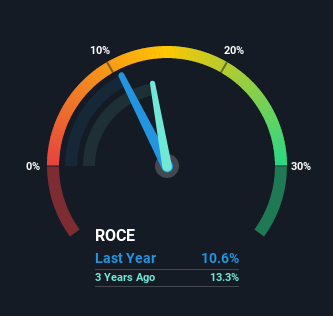- India
- /
- Auto Components
- /
- NSEI:MRF
Some Investors May Be Worried About MRF's (NSE:MRF) Returns On Capital

Did you know there are some financial metrics that can provide clues of a potential multi-bagger? Ideally, a business will show two trends; firstly a growing return on capital employed (ROCE) and secondly, an increasing amount of capital employed. This shows us that it's a compounding machine, able to continually reinvest its earnings back into the business and generate higher returns. However, after briefly looking over the numbers, we don't think MRF (NSE:MRF) has the makings of a multi-bagger going forward, but let's have a look at why that may be.
Understanding Return On Capital Employed (ROCE)
For those that aren't sure what ROCE is, it measures the amount of pre-tax profits a company can generate from the capital employed in its business. Analysts use this formula to calculate it for MRF:
Return on Capital Employed = Earnings Before Interest and Tax (EBIT) ÷ (Total Assets - Current Liabilities)
0.11 = ₹17b ÷ (₹230b - ₹71b) (Based on the trailing twelve months to September 2021).
Thus, MRF has an ROCE of 11%. That's a relatively normal return on capital, and it's around the 13% generated by the Auto Components industry.
Check out our latest analysis for MRF

In the above chart we have measured MRF's prior ROCE against its prior performance, but the future is arguably more important. If you'd like, you can check out the forecasts from the analysts covering MRF here for free.
What The Trend Of ROCE Can Tell Us
On the surface, the trend of ROCE at MRF doesn't inspire confidence. Around five years ago the returns on capital were 24%, but since then they've fallen to 11%. However, given capital employed and revenue have both increased it appears that the business is currently pursuing growth, at the consequence of short term returns. And if the increased capital generates additional returns, the business, and thus shareholders, will benefit in the long run.
In Conclusion...
While returns have fallen for MRF in recent times, we're encouraged to see that sales are growing and that the business is reinvesting in its operations. And the stock has followed suit returning a meaningful 41% to shareholders over the last five years. So should these growth trends continue, we'd be optimistic on the stock going forward.
MRF could be trading at an attractive price in other respects, so you might find our free intrinsic value estimation on our platform quite valuable.
While MRF may not currently earn the highest returns, we've compiled a list of companies that currently earn more than 25% return on equity. Check out this free list here.
New: Manage All Your Stock Portfolios in One Place
We've created the ultimate portfolio companion for stock investors, and it's free.
• Connect an unlimited number of Portfolios and see your total in one currency
• Be alerted to new Warning Signs or Risks via email or mobile
• Track the Fair Value of your stocks
Have feedback on this article? Concerned about the content? Get in touch with us directly. Alternatively, email editorial-team (at) simplywallst.com.
This article by Simply Wall St is general in nature. We provide commentary based on historical data and analyst forecasts only using an unbiased methodology and our articles are not intended to be financial advice. It does not constitute a recommendation to buy or sell any stock, and does not take account of your objectives, or your financial situation. We aim to bring you long-term focused analysis driven by fundamental data. Note that our analysis may not factor in the latest price-sensitive company announcements or qualitative material. Simply Wall St has no position in any stocks mentioned.
About NSEI:MRF
MRF
Engages in the manufacture, sale, and trading of rubber products in India and internationally.
Flawless balance sheet with proven track record.


